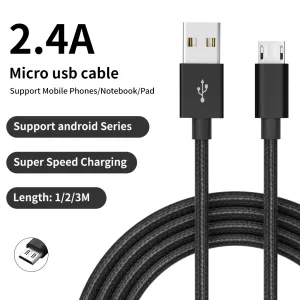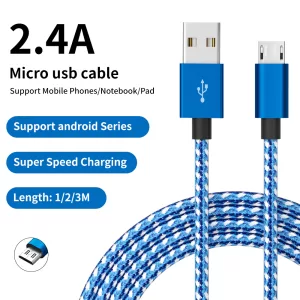The Micro USB cable has been a vital accessory in the world of technology for years, serving as a primary connector for various devices. Identifying a Micro USB cable, however, can be confusing due to the myriad of charging and data cables available today. This guide will help you distinguish a Micro USB cable from others by highlighting its unique features, uses, and identifying characteristics.
What Is a Micro USB Cable?
A Micro USB (Universal Serial Bus) cable is a standard interface used to connect devices for charging and data transfer. It was widely adopted for smartphones, cameras, tablets, and other small electronic devices before the advent of USB-C. Micro USB cables are recognized for their compact size and symmetrical trapezoidal shape.
Why Is Identifying a Micro USB Cable Important?
With the variety of cables on the market, using the correct one is crucial to ensure:
Device Compatibility – Preventing damage to the device or port.
Optimal Performance – Ensuring proper charging speed and reliable data transfer.
Longevity of Ports – Avoiding wear caused by forcing incompatible connectors.
Understanding how to identify a Micro USB cable can save time and prevent potential frustration.
Physical Characteristics of a Micro USB Cable
1. Connector Shape
The Micro USB connector has a distinctive shape:
Trapezoidal Design – It features a wider top and narrower bottom, creating an asymmetrical profile.
Flat Orientation – The connector’s bottom is flat, while the top typically has ridges or an engraved logo.
2. Connector Size
Micro USB connectors are smaller than standard USB-A connectors but larger than USB-C connectors. This size makes them suitable for compact devices without compromising functionality.
3. Pin Configuration
The Micro USB connector typically has 5 pins for charging and data transfer:
1 Pin for power.
4 Pins for data and ground connections.
4. Cable Type
Micro USB cables are often:
Thin and flexible for ease of use.
Labeled with “Micro USB” on packaging or the connector itself.
Comparing Micro USB to Other Cables
1. Micro USB vs. USB-C
Shape: Micro USB is trapezoidal, while USB-C is oval and symmetrical.
Reversibility: Micro USB connectors fit only one way, whereas USB-C is reversible.
Speed: USB-C supports faster charging and data transfer compared to Micro USB.
2. Micro USB vs. Mini USB
Size: Mini USB connectors are larger and more robust than Micro USB.
Usage: Mini USB was commonly used in older devices like cameras, while Micro USB became the standard for modern devices.
Identifying a Micro USB Cable Through Labels
Some cables feature clear labels or icons to indicate their type:
Look for “Micro USB” or a symbol resembling the connector shape.
Check the packaging or manufacturer’s specifications if the cable is new.
Devices That Use Micro USB Cables
Micro USB cables are used in a wide range of devices, including:
Older Android smartphones and tablets.
Bluetooth speakers and headphones.
Digital cameras and portable gaming devices.
External hard drives and power banks.
Practical Tips for Identifying a Micro USB Cable
1. Inspect the Connector
Carefully examine the connector for its trapezoidal shape and 5-pin configuration.
2. Compare with Other Cables
Place the cable alongside USB-C or Mini USB cables to distinguish differences in size and shape.
3. Test the Fit
Insert the connector into a known Micro USB port. If it fits snugly, it’s likely a Micro USB cable.
4. Check Manufacturer Information
Reputable brands often provide clear labeling or documentation to identify their cables.
Common Misconceptions About Micro USB Cables
1. All USB Cables Are the Same
Many assume that any USB cable will work for any device. In reality, using the wrong cable can result in slower charging or no connectivity.
2. Micro USB Is Outdated
Although USB-C is becoming the new standard, Micro USB cables remain relevant for millions of devices still in use.
3. All Micro USB Cables Offer Fast Charging
Not all Micro USB cables support fast charging. To ensure this capability, check for compatibility with Quick Charge or similar technologies.
Maintaining Your Micro USB Cables
To extend the life of your Micro USB cables:
Avoid Bending: Prevent kinks and twists to maintain the cable’s integrity.
Keep Clean: Dust and debris in the connector can affect performance.
Store Properly: Use cable organizers to avoid tangling and breakage.
Innovations and Alternatives to Micro USB
The technology industry is gradually transitioning to USB-C due to its enhanced capabilities. However, hybrid cables with Micro USB, USB-C, and Lightning connectors provide a versatile solution for users with multiple devices.
Conclusion
Identifying a Micro USB cable is straightforward when you know what to look for. By recognizing its unique trapezoidal shape, 5-pin configuration, and compact size, you can confidently distinguish it from other cables. Despite the rise of USB-C, Micro USB cables remain an essential accessory for many devices, making it crucial to understand their features and uses.
By following this guide, you’ll not only save time but also ensure compatibility and optimal performance for your devices. Whether you’re organizing your accessories, troubleshooting connectivity issues, or simply curious, understanding Micro USB cables is a valuable skill in today’s tech-driven world.


